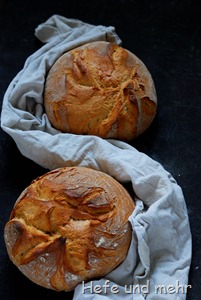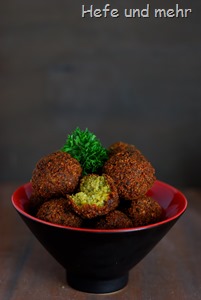 After the successful disputation we always have a little party with delicious food. After the exiting defense the newly made doctor need something to refresh and we others need it as well. There is nothing more existing for all of us!
After the successful disputation we always have a little party with delicious food. After the exiting defense the newly made doctor need something to refresh and we others need it as well. There is nothing more existing for all of us!
For the last defense I was asked to make Falafel and so I spend the morning rolling them. I needed 45 min to form 100 Falafel and after 50 I asked myself if I was doing to many. But when I then placed the freshly fried falafels on the buffet, they were gone so fastly that I knew that 100 was the perfect number. And when I was asked if the recipe is already on the blog, I had to say no. But now it is 🙂

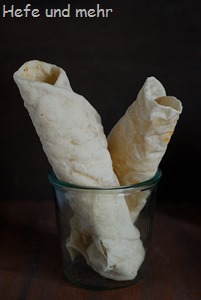 Do you know this? You take a photograph, and another one, and another one. And nothing looks good. This Arabian flatbread, Chubz, is one of this cases. It is so … flat. After ten minutes of unsatisfying pictures my beloved one turn nervous and declared that bread and
Do you know this? You take a photograph, and another one, and another one. And nothing looks good. This Arabian flatbread, Chubz, is one of this cases. It is so … flat. After ten minutes of unsatisfying pictures my beloved one turn nervous and declared that bread and 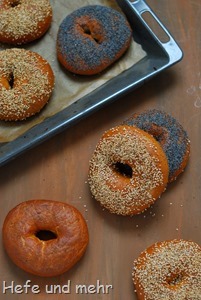 I was asked to include a bagel recipe in my little course about bread baking and I was very willing to do so. Bagels are a good recipe for beginners as the dough is quite firm and not sticky at all. Kneading on the other hand can be a little work out because of the firm dough, too. But kneading a bagel dough is important to get a chewy bagel. So turn on some music and start kneading!
I was asked to include a bagel recipe in my little course about bread baking and I was very willing to do so. Bagels are a good recipe for beginners as the dough is quite firm and not sticky at all. Kneading on the other hand can be a little work out because of the firm dough, too. But kneading a bagel dough is important to get a chewy bagel. So turn on some music and start kneading!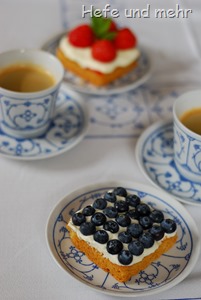
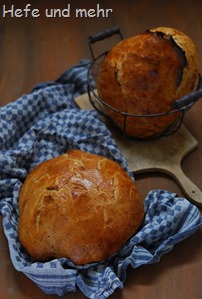 “Eingenetztes Brot” would be Net-Bread if translated literally. But the origin from the word “eingenetzt” does not stem from the German “Netz” (net) but from “Nass”, which means “Wet”. And making the bread is wet indeed. The sticky dough is easiest to handle when hands and tools are really wet. When the bread is placed in the oven its surface is wet as well. This helps to create the shiny crust which is characteristic for this bread. To get the soft dough in the oven without accident, a so called “Schapf”, a kind of ladle, is used traditionally. Even in my rather big kitchen collection, there is no “Schapf” and so I used a small salad bowl instead. And this worked fine!
“Eingenetztes Brot” would be Net-Bread if translated literally. But the origin from the word “eingenetzt” does not stem from the German “Netz” (net) but from “Nass”, which means “Wet”. And making the bread is wet indeed. The sticky dough is easiest to handle when hands and tools are really wet. When the bread is placed in the oven its surface is wet as well. This helps to create the shiny crust which is characteristic for this bread. To get the soft dough in the oven without accident, a so called “Schapf”, a kind of ladle, is used traditionally. Even in my rather big kitchen collection, there is no “Schapf” and so I used a small salad bowl instead. And this worked fine!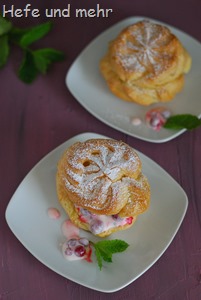 Until now our year was an exhausting one. So we needed a break to refresh and so we headed to the beautiful East Frisia. After a week with some sun, wind and as only sound birds singing in the trees we came back relaxed and happy. After unpacking the car I started to think to finish our short vacation with some sweet treats. A quick look in the fridge revealed some eggs and cream and in the freezer I found some currants from the last year (it is really time to use them!). And about two hours later our table was set with some Cream puffs and coffee.
Until now our year was an exhausting one. So we needed a break to refresh and so we headed to the beautiful East Frisia. After a week with some sun, wind and as only sound birds singing in the trees we came back relaxed and happy. After unpacking the car I started to think to finish our short vacation with some sweet treats. A quick look in the fridge revealed some eggs and cream and in the freezer I found some currants from the last year (it is really time to use them!). And about two hours later our table was set with some Cream puffs and coffee.